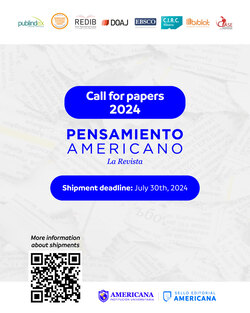Iconographic analysis of pictorial type, as a nation builder in Argentina during the first half of the nineteenth century (1810 - 1852)
DOI:
https://doi.org/10.21803/penamer.15.29.357Keywords:
Pictorial art, Argentina, Customs, Identity, Iconographic AnalysisAbstract
This article analyzes representative examples of pictorial art in Argentina during the first half of the 19th century through the study of iconographic representations, which, when compared with written sources, reveal allegories, symbols and national identities. These show the socio-cultural transitions of political type, which were portrayed by foreign and native artists in the visual imaginary comprised by two periods 1810- 1829 and 1830 - 1852. In the first period, the beginnings of modern Argentine pictorial art express in their works the heroic legacy left by the liberation campaigns and the heroes of the country, within the framework of neoclassicism that will be reflected throughout the first half of the 19th century. In the second period the themes and symbols change to reflect a nationalism that gained strength through the image as a visual discourse by means of the dictatorial regime of General Juan Manuel de Rosas.
Downloads
References
Abad, B. F. (2017). El Arte de América Latina en el siglo XIX. En M. Ugarte, Atlas Histórico de América Latina y el Caribe (págs. 621-742). Remedios de Escalada Lanús. REUN.
Amigo, R. (2013) Carlos Morel. El costumbrismo federal. Caiana. Revista de Historia del Arte y Cultura Visual del Centro Argentino de Investigadores de Arte. (3). 25-44. https://es.scribd.com/document/256658696/Amigo-Morel-Costumbrismo-Federal
Annino, A. y Guerra. F. (2003). Inventando la nación. Iberoamérica. Siglo XIX. Fondo de Cultura Económica.
Barni, R. (2019). El recuerdo de Maipú, la batalla decisiva para impulsar la independencia de América del Sur. TN. https://
tn.com.ar/sociedad/el-recuerdo-de-maipu-la-batalla-decisiva-para-impulsar-la-independencia-de-america-del-sur_953031/
Capasso, V. (2012). El discurso visual durante el régimen rosista: imbricaciones entre lo público y lo privado. pp. 1-10. VI jornadas de investigación en disciplinas artísticas y proyectuales (La Plata). http://sedici.unlp.edu.ar/handle/10915/40943
Domínguez, A. J. (2003). El enemigo unitario en el discurso rosista. Anuario de Estudios Americanos.60(2). 557-579. https://doi.org/10.3989/aeamer.2003.v60.i2.158
Gericault, T. (1819). Batalla de Maipú [litografía]. Buenos Aires, Museo Histórico Nacional de Buenos Aires. http://bp3.blogger.com/
Giordano, M. (2009). Nación e Identidad en los Imaginarios Visuales. ARBOR Ciencia Pensamiento y Cultura, 185(740). 1-16.
Ministerio de Educación (Argentina). (2010). Bicentenario "las fiestas mayas". Buenos Aires gobierno de la ciudad. http://
www.bnm.me.gov.ar/giga1/documentos/EL002062.pdf
Monvoisin, R. (1842) Retrato Juan Manuel de Rosas [pintura]. Buenos Aires, museo de Bellas Artes de Buenos Aires. https://
www.bellasartes.gob.ar/coleccion/obra/1913/
Morel, C. (1844) El mercado de carretas en la plaza Monserrat [pintura]. Buenos Aires, museo de Bellas Artes de Buenos Aires. http://carlosraulrisso-escritor.blogspot.com/2015/04/carlos-morel-el-del-criollo-pincel.html
Panofsky, E. (1979). Iconografía e iconología: introducción al estudio del arte del Renacimiento. El significado en las artes visuales (pp. 9-387). Alianza Forma.
Pellegrini, C. (1841). Fiestas Mayas [pintura]. Buenos Aires, museo de Bellas Artes de Buenos Aires. http://ilustracionhistoricaargentina.
blogspot.com/2017/05/fiestas-mayas.html
Revisionistas. (2008). Plaza Monserrat. http://www.revisionistas. com.ar/?p=7771
Viñuales, R. G. (2003). Síntesis histórica del arte en la Argentina (1776-1930) Granada. https://www.ugr.es/~rgutierr/PDF2/LIB%20007.pdf
Waldo, A. (1981). La forja de un dictador. El caso Juan Manuel de Rosas. Crítica & Utopía. Latinoamericana de Ciencias Sociales (No. 5)
Downloads
Published
Versions
- 2024-07-05 (3)
- 2024-06-12 (2)
- 2022-05-20 (1)
Issue
Section
License
Copyright (c) 2022 Pensamiento Americano

This work is licensed under a Creative Commons Attribution-NonCommercial-NoDerivatives 4.0 International License.
The author or authors of an article accepted for publication in the Journal Pensamiento Americano will transfer all of the patrimonial rights to the American University Corporation free of charge, within which are included: the right to edit, publish, reproduce and distribute both print media as digital, in addition to include in article in international indexes and / or databases, likewise, the Editorial Seal is authorized to use the images, tables and / or any graphic material presented in the article for the design of covers or posters from the same magazine. By assuming the patrimonial rights of the article, it may not be partially or totally reproduced in any printed or digital media without its express permission.
AUTHORITY ASPECTS
For the Pensamiento Americano Journal, all the authors of an article have made substantial contributions to the research and the manuscript, and they share the responsibility when the article presents errors, fraud in some way or violations of copyright.
After submitting an article, the journal does not accept the addition, deletion or change in the order of the authors, in addition we reserve the right to release the article when it has been submitted to the journal and under no circumstances will American Thought accept the article. withdrawal of an article during any phase of the editorial process






